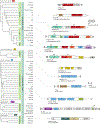A Field Guide to Eukaryotic Transposable Elements
- PMID: 32955944
- PMCID: PMC8293684
- DOI: 10.1146/annurev-genet-040620-022145
A Field Guide to Eukaryotic Transposable Elements
Abstract
Transposable elements (TEs) are mobile DNA sequences that propagate within genomes. Through diverse invasion strategies, TEs have come to occupy a substantial fraction of nearly all eukaryotic genomes, and they represent a major source of genetic variation and novelty. Here we review the defining features of each major group of eukaryotic TEs and explore their evolutionary origins and relationships. We discuss how the unique biology of different TEs influences their propagation and distribution within and across genomes. Environmental and genetic factors acting at the level of the host species further modulate the activity, diversification, and fate of TEs, producing the dramatic variation in TE content observed across eukaryotes. We argue that cataloging TE diversity and dissecting the idiosyncratic behavior of individual elements are crucial to expanding our comprehension of their impact on the biology of genomes and the evolution of species.
Keywords: genome evolution; retrotransposons; transposable element origins; transposition mechanisms; transposons.
Conflict of interest statement
DISCLOSURE STATEMENT
The authors are not aware of any financial conflicts of interest affecting the objectivity of this review.
Figures



References
-
- Ågren JA, Wright SI. 2011. Co-evolution between transposable elements and their hosts: A major factor in genome size evolution? Chromosom. Res 19(6):777–86 - PubMed
-
- Aravin AA, Hannon GJ, Brennecke J. 2007. The Piwi-piRNA Pathway Provides an Adaptive Defense in the Transposon Arms Race. Science (80-. ). 318(5851):761–64 - PubMed
-
- Arkhipova IR, Pyatkov KI, Meselson M, Evgen’ev MB. 2003. Retroelements containing introns in diverse invertebrate taxa. Nat. Genet 33(2):123–24 - PubMed
Publication types
MeSH terms
Substances
Grants and funding
LinkOut - more resources
Full Text Sources
Other Literature Sources

